The Future of Storage Tank Manufacturing: Trends and Technologies to See
The storage tank manufacturing market is on the cusp of a pivotal advancement, driven by arising trends in clever materials, automation, and sustainability. As industries significantly prioritize ecological obligation, innovations such as environment-friendly compounds and IoT-driven surveillance systems are reshaping functional paradigms. In enhancement, the growing demand for personalization and modular designs recommends a shift in the direction of more adaptable production methods. Recognizing these patterns not just highlights the challenges in advance but likewise reveals chances that could redefine the landscape of storage tank production in the coming years. What effects might these developments hold for sector stakeholders?
Developments in Smart Products
In the last few years, the storage tank manufacturing sector has actually experienced a considerable uptick in the fostering of smart products, reinventing design and performance. Smart products, which can react dynamically to environmental modifications, have actually made it possible for manufacturers to create storage tanks that are not just extra resilient however additionally more effective in their operational abilities.
One remarkable innovation is the assimilation of form memory alloys and polymers that can adjust to differing stress and temperature levels. This versatility improves the structural integrity of tanks, reducing the risk of failures and leaks (Texas Oil & Gas Storage Tank Fabrication Authority). In addition, these products frequently exhibit self-healing residential or commercial properties, which further lengthens the life expectancy of storage space containers, reducing upkeep costs and improving safety
Moreover, the unification of sensors within clever materials permits real-time tracking of container conditions, giving essential data that aids in predictive upkeep and risk monitoring. This data-driven strategy not only enhances functional performance but likewise straightens with environmental sustainability goals by maximizing resource usage and protecting against spills.
Rise of Automation Technologies
The increase of automation modern technologies is changing storage tank manufacturing by integrating robotics right into manufacturing processes, improving performance and accuracy. Additionally, the implementation of clever sensing units makes it possible for real-time tracking, making sure quality assurance and safety requirements are satisfied. AI-driven procedure optimization better streamlines operations, decreasing expenses and enhancing general efficiency in the market.
Robotics Combination in Manufacturing
Robotics combination is reinventing the production landscape, specifically in the storage tank field. As manufacturers undertaking for raised performance and accuracy, robotics modern technologies are ending up being essential devices for simplifying manufacturing procedures. Automated systems are capable of doing repeated tasks with greater rate and precision than human labor, minimizing the likelihood of errors and boosting overall product top quality.
One of the crucial advantages of robot combination is the capacity to optimize process. Automated robotic arms can handle hefty materials, weld parts, and carry out inspections, which lessens physical pressure on workers and minimizes downtime. This shift not just enhances safety yet likewise allows human staff members to concentrate on more facility and value-added tasks.
Moreover, robotics can help with versatile manufacturing, allowing business to adjust rapidly to changing market demands - Oil & Gas Storage Tank Fabrication. Advanced programs permits robots to easily switch in between various jobs and items, which is specifically helpful in a market where modification is increasingly wanted
As robotics modern technology continues to develop, manufacturers can expect boosted capacities, consisting of improved equipment discovering formulas and augmented reality applications, better driving effectiveness in storage tank production and setting new requirements for the sector.
Smart Sensors Release

Additionally, the information collected from these sensing units can be leveraged to enhance the supply chain, ensuring that products are available when needed while minimizing waste. This degree of understanding permits manufacturers to respond swiftly to transforming problems and customer demands, boosting overall productivity.
Additionally, wise sensors add to boosted regulatory conformity by constantly keeping track of ecological elements and guaranteeing adherence to safety and security criteria. As the market proceeds in the direction of more sustainable techniques, the ability to keep an eye on exhausts and resource usage in real-time is indispensable.
AI-Driven Process Optimization
Manufacturers in the storage tank sector are progressively harnessing the power of AI-driven procedure optimization to boost operational efficiency and decision-making abilities. By integrating sophisticated formulas and maker understanding strategies, business can evaluate substantial amounts of information produced throughout the manufacturing process. This data-driven technique makes it possible for real-time monitoring of manufacturing metrics, leading to more timely interventions and educated choices.
AI innovations promote anticipating maintenance, allowing manufacturers to expect tools failings before they take place, consequently decreasing downtime and maintenance costs. Furthermore, these systems can optimize resource allocation by assessing production patterns and adjusting workflows, making certain that materials and labor are utilized successfully.
In addition, AI-driven optimization boosts quality assurance by identifying prospective issues during the production process. Automated examinations powered by AI can swiftly discover variances, guaranteeing that only items meeting strict high quality standards progress with the production line.
As the storage tank sector continues to embrace automation, AI-driven procedure optimization stands out as a transformative pressure, driving development and competitiveness. By leveraging these technologies, manufacturers can not just enhance procedures however also adjust promptly to market needs, positioning themselves for lasting growth in an increasingly complicated manufacturing landscape.
Concentrate On Sustainability Practices
As the storage tank manufacturing market evolves, a considerable focus is put on sustainability techniques. This consists of the fostering of environment-friendly products, the execution of energy-efficient manufacturing procedures, and the combination of round economic situation principles. By focusing on these campaigns, manufacturers not just reduce their environmental influence but additionally enhance the durability and efficiency of their items.
Eco-friendly Materials Adoption
Progressively, the storage tank production market is accepting eco-friendly materials as a basic facet of sustainability practices. This change is driven by enhanced ecological awareness and governing stress, prompting manufacturers to look for options that lessen environmental influence.
Eco-friendly composites and recycled steels are acquiring grip, offering both efficiency and lower carbon impacts. Utilizing high-recycled-content steel not only minimizes the demand for virgin products yet also improves the overall sustainability of the product lifecycle. Furthermore, manufacturers are exploring bio-based resins that offer resilience while being less harmful to the atmosphere.
The fostering of environment-friendly finishes and surfaces, which are cost-free from unstable natural substances (VOCs), reflects the sector's dedication to decreasing air pollution and advertising healthier working problems. These technologies not just line up with international sustainability goals but additionally satisfy the growing market demand for greener items.
The assimilation of eco-friendly products in storage tank production is not just a trend; it represents a positive approach towards liable production that prioritizes both environmental stewardship and financial practicality, establishing a brand-new standard for future growths in the market.
Energy-efficient Manufacturing Processes
There is a growing recognition within the storage tank manufacturing sector of the significance of energy-efficient processes as an important component of sustainable practices. As the market encounters enhancing stress to lower its carbon impact, manufacturers are applying innovative modern technologies and methods aimed at lessening energy intake throughout the production cycle.
One significant fad is the adoption of innovative manufacturing methods such as lean manufacturing and automation. These approaches simplify procedures, reduce waste, and boost productivity, while also reducing power usage. Additionally, the combination of eco-friendly energy resources, such as solar and wind power, into manufacturing facilities is becoming much more widespread, permitting companies to run sustainably and minimize dependence on fossil fuels.
Energy-efficient machinery and equipment are being focused on in brand-new financial investments, as manufacturers look for to maximize their power usage. The usage of power administration systems allows real-time tracking and evaluation, promoting continual renovation in energy effectiveness.
Circular Economy Combination
A remarkable change towards circular economy assimilation is transforming sustainability practices within the storage tank manufacturing market. This strategy stresses the value of resource effectiveness, waste reduction, and the recycling of products throughout the manufacturing lifecycle. By adopting circular principles, manufacturers are increasingly concentrated on making storage tanks that prioritize repairability, recyclability, and long life.
As part of this change, firms are checking out innovative products and manufacturing methods that decrease environmental effect. The incorporation of recycled steels and plastics not only lowers the need for virgin resources however additionally reduces carbon emissions related to extraction and handling. Additionally, manufacturers are implementing take-back plans that assist in the repair and recycling of end-of-life storage tanks, thus closing the loop in the production cycle.
Cooperation amongst stakeholders, including providers and consumers, is vital for cultivating a circular economic situation (Oil & Gas Storage Tank Fabrication). This partnership makes it possible for the sharing of best methods and urges the growth of sustainable supply chains. Eventually, incorporating round economic situation principles into storage tank manufacturing not just improves ecological stewardship but also positions business to fulfill advancing regulatory requirements and customer assumptions for sustainability
Boosted Safety And Security Protocols
In today's manufacturing landscape, enhanced security procedures have actually come to be necessary for storage tank manufacturers. The sector faces enhancing regulative analysis and needs for higher safety standards due to the possible risks associated with the storage of harmful products. Manufacturers are taking on a complex technique to enhance safety actions throughout the manufacturing process.
One considerable advancement is the implementation of innovative risk analysis devices that determine potential hazards throughout the layout and manufacturing stages. These devices assist in positive measures to minimize dangers before they rise right into essential problems. Furthermore, manufacturers are purchasing staff member training programs that stress security methods, guaranteeing that all employees are skilled in emergency treatments and equipment handling.
Furthermore, there is an expanding emphasis on the usage of high-grade products and cutting-edge designs that boost structural stability and reduce the probability of failures or leaks. Routine upkeep checks and extensive screening methods are likewise being integrated into the manufacturing lifecycle to ensure compliance with safety and security policies.
Integration of IoT Solutions

IoT devices promote anticipating upkeep, which lessens downtime and prolongs the life expectancy of storage space tanks. By evaluating information accumulated from sensors, manufacturers can perform and foresee possible failings maintenance tasks prior to important concerns develop. This aggressive method not only conserves costs however also guarantees conformity with safety regulations.
Additionally, IoT assimilation sustains much better stock monitoring by giving precise, real-time information on saved products. Texas Oil & Gas Storage Tank Fabrication Authority. This capacity aids manufacturers maximize their supply chains, guaranteeing that necessary sources are offered when required, thus improving overall efficiency
The application of IoT services enables enhanced communication between storage tanks and central management systems, enhancing operations. As the storage tank production industry continues to embrace IoT innovations, we can expect substantial innovations in security methods and functional effectiveness, inevitably causing even more resistant production techniques.
Customization and Modular Style
Versatility in layout has actually come to be a foundation of modern-day storage tank manufacturing as personalization and modular design alternatives gain traction. The developing demands of sectors such as oil and gas, chemicals, and water management necessitate tailored remedies that suit particular operational requirements. Personalization makes it possible for manufacturers to create containers that meet unique requirements relating to size, shape, functionality, and material, guaranteeing peak performance and effectiveness.
Modular design, on the various other hand, enables the assembly of pre-fabricated parts, causing considerable time and cost financial savings. This technique facilitates quick deployment and scalability, enabling services to adjust their storage space capabilities in feedback to fluctuating demand. Additionally, modular systems can be easily broadened or reconfigured, reducing downtime and boosting functional flexibility.
The assimilation of sophisticated production innovations, such as 3D printing and computer-aided style (CAD), more boosts modification opportunities. These advancements make it possible for specific engineering and rapid prototyping, permitting quick changes and models during the style procedure.

Regulatory Changes and Conformity
Regulative changes and compliance requirements frequently shape the landscape of storage tank production, engaging manufacturers to remain versatile and cautious. With enhancing ecological worries and the promote lasting practices, regulative bodies are implementing more stringent guidelines concerning exhausts, materials, and safety standards. For circumstances, the U.S. Environmental Security Company (EPA) and numerous state firms are changing guidelines that control the style and installation of tank, specifically those utilized for hazardous substances.
Manufacturers must not only follow existing regulations but likewise anticipate future changes, demanding recurring financial investment in r & d. This consists of taking on ingenious products and innovations that boost tank honesty and environmental management. look at this now Additionally, conformity with regulations such as the Spill Avoidance, Control, and Countermeasure (SPCC) rule is essential for manufacturers to prevent legal responsibilities and large fines.
In addition, the combination of digital technologies facilitates conformity surveillance and reporting, enabling manufacturers to maintain transparency and performance. As guidelines remain to advance, remaining notified and aggressive is necessary for storage tank manufacturers to guarantee conformity, secure public wellness, and protect the environment, eventually shaping an extra lasting sector.
Often Asked Questions

What Are the Many Usual Products Made Use Of in Storage Tank Manufacturing?
One of the most common materials made use of in storage tank manufacturing include carbon steel, stainless-steel, and fiberglass. Each product supplies unique benefits, such as resilience, deterioration resistance, and flexibility to different storage space needs and environmental conditions.
Just How Do Tank Effect Citizen Ecosystems Throughout Installment?
Storage storage tank installment can disrupt neighborhood ecosystems by modifying land use, impacting water drain patterns, and potentially introducing pollutants. Appropriate website assessments and ecological administration techniques are important to mitigate these effects and safeguard biodiversity.
What Is the Typical Lifespan of a Modern Storage Tank?
The typical lifespan of a contemporary storage tank normally varies from 20 to 30 years. Variables such as worldly quality, ecological problems, and upkeep techniques significantly affect longevity and total performance throughout their operational life-span.
Just How Do Manufacturers Make Sure Quality Assurance in Production?
Manufacturers ensure quality assurance with rigorous screening methods, adherence to market criteria, and continuous tracking throughout manufacturing (Oil & Gas Storage Tank Fabrication). Advanced innovations such as automation and real-time information analysis better enhance consistency and reliability in storage tank production procedures
What Are the Prices Associated With Preserving Tank?
Maintaining tank involves different expenses, consisting of regular assessments, repair services, regulative compliance, corrosion avoidance, and possible environmental removal. These expenses can significantly impact total operational spending plans and necessitate positive management to assure lasting effectiveness and safety and security.
As manufacturers increasingly welcome automation modern technologies, the deployment of wise sensing units is becoming an essential facet of contemporary manufacturing processes in the storage tank market. Manufacturers in the storage container sector are progressively taking advantage of the power of AI-driven process optimization to improve functional performance and decision-making capabilities. Increasingly, the storage container production sector is welcoming green materials as a basic element of sustainability practices. In today's manufacturing landscape, enhanced security procedures have actually become important for storage space container manufacturers. Regulative changes and conformity requirements frequently form the landscape of storage space tank production, compelling manufacturers to stay versatile and cautious.